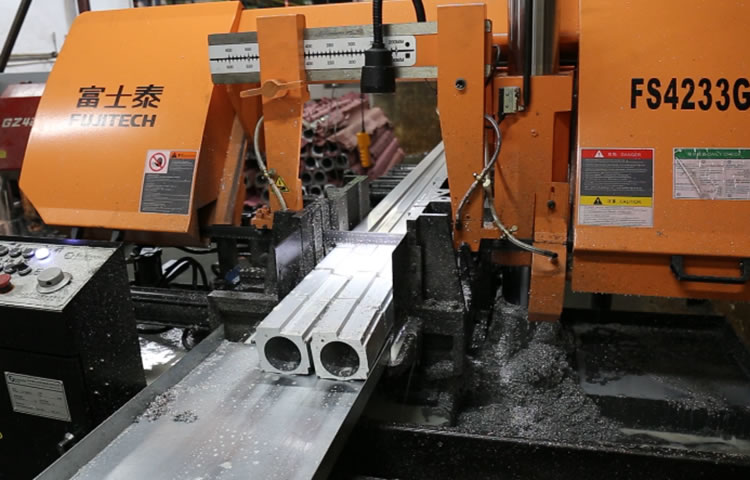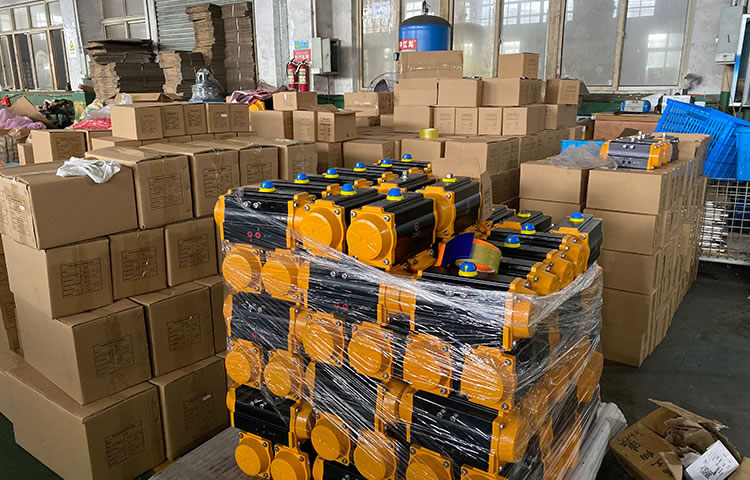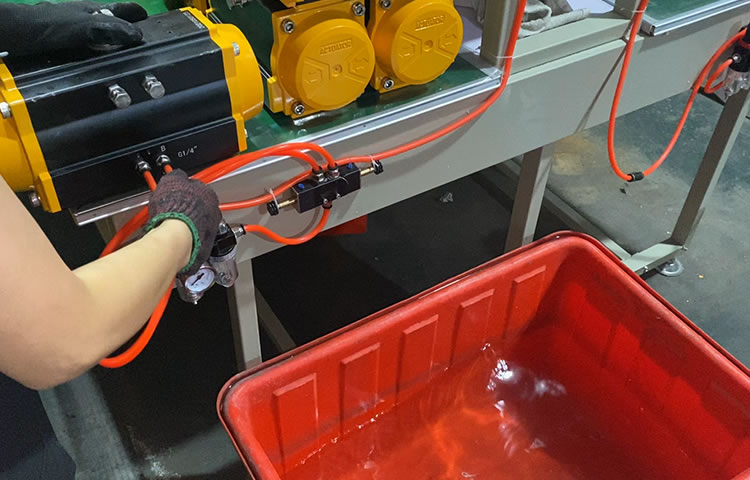Pneumatic Butterfly Valve
Pneumatic Butterfly Valve Optimize Your Flow Control with Advanced Pneumatic Solutions.
Pneumatic Butterfly Valve Optimize Your Flow Control with Advanced Pneumatic Solutions.
The pneumatic butterfly valve is composed of a pneumatic actuator and a butterfly valve. A pneumatic butterfly valve is a pneumatic valve that uses a circular butterfly plate that rotates with the valve stem to open and close to achieve the activation action. It is mainly used as a cut-off valve. It can also be designed to have the function of regulating or blocking and regulating.
Air-operated butterfly valves have gained popularity as a preferred option for a wide range of industrial process control applications. Thanks to their efficient design, they can open and close rapidly, precisely regulating pressure and flow rate with ease.
Moreover, these valves boast a sturdy construction that guarantees durability and enables them to operate for long periods, even in tough and demanding environments. Additionally, the actuated butterfly valves can be equipped with PTFE or FKM lining, which offers enhanced chemical resistance and corrosion protection compared to standard metal valves.
The butterfly valves with pneumatic actuators are suitable for performing shutoff, throttling, or regulating services in numerous industries, such as oil refineries, water treatment units, and chemical plants. Invest in an air-actuated butterfly valve today and enjoy superior results!
The primary function of a pneumatic butterfly valve is to manage the flow of fluid or air in a pipe. It comprises a flat, circular disc that rotates about its axis. This disc is linked to an actuator on the exterior and can be operated either by hand or through automated means using compressed air.
When the valve is in the open position, the disc rotates 90 degrees, becoming parallel to the flow direction of the pipe. Through this rotation, it enables an unobstructed flow within the pipe, and no pressure drop takes place as there are no barriers present. However, when the valve is closed, the disc pivots in such a manner that its edge obstructs any further passage for fluids or gases, thereby controlling the speed at which they can move along within the pipes.
In terms of working principles, pneumatic butterfly valves primarily depend on linear motion that is regulated by their actuator. This actuator functions based on the differential pressures acting on the opposite sides of its diaphragm or piston head. These differential pressures are usually supplied by compressor pumps that are directly connected to the valves via small inlets near their bodies.
As previously explained, once activated in one way, these valves can completely block the flow path. Conversely, if activated in another way, they allow the flow to move freely. This characteristic makes them quite versatile when utilized appropriately, depending on the specific requirements regarding fluid control dynamics powered by pneumatics that our systems need to achieve as results.
For pneumatic butterfly valves, several accessories are necessary to ensure optimal performance, such as actuators, limit switches, solenoids, and fieldbus controllers, among others.
Actuators: Pneumatic actuators are responsible for generating the essential force required to open and close the valve. The actuation is mainly achieved via diaphragm or piston mechanisms. In the specific context of pneumatic butterfly valves, diaphragm actuation is typically favored due to its capacity to deliver a more fluid operation in contrast to alternative techniques like cylinder/spring combinations.
Limit Switches: Limit switches are designed to sense the proper opening or closing of the valve and relay this status by emitting electrical signals back to control entities like Programmable Logic Controllers (PLCs). Depending on the specific kind of switch, be it reed or proximity type, they can be mounted either directly onto the valve structure or onto an auxiliary bracket which is then secured to the framework of the overall system. This setup essentially offers feedback concerning the exactitude of the valve’s opening and closing operations.
Pneumatic solenoid valves are electromechanical apparatuses that are utilized for governing the flow of compressed air and other fluids. They function using an electrical current traversing a coil, which then either opens or closes a valve that is attached to it. The current flowing through the coil gives rise to a magnetic field. This magnetic field exerts a force on the solenoid’s plunger, making it shift either upward or downward and thereby opening or closing the valve correspondingly.
Pneumatic butterfly valves find application in a diverse range of industries. These encompass, without limitation, water and wastewater treatment plants, irrigation systems, food production and processing facilities, chemical applications like oil refineries and petrochemical plants, pharmaceutical manufacturing sites, power generation stations, and also boilers and process heating/cooling systems.
Pneumatic actuator butterfly valves present several benefits in comparison to other valve varieties. Their full-flow design, which lacks dead space, facilitates easier cleaning. The disc’s rising action is self-cleaning as a result of the fluid passing through. They are lighter than other valve types, leading to a reduction in installation costs. The valves have a straightforward design, rendering them simple to use and repair if the need arises. Their tight seal averts the backflow of hazardous substances, which can pose risks in specific industrial applications. Additionally, pneumatic butterfly valves are fail-safe open, eliminating the potential for losses due to failure or jamming during operation.
In addition to the aforementioned advantages, in industrial settings, the utilization of pneumatic butterfly valves also consumes less energy in contrast to traditional gate or globe valves. This is because a smaller quantity of air pressure (as opposed to solenoid current) is required and it takes less time to operate them. Over an extended period, this can result in substantial savings on energy expenditures when compared to the operations of manually operated gate or globe valves in some large industrial facilities where this particular type of valve is frequently employed.






Based on a wealth of experience, YUECHI has the knowledge to provide reliable and appropriate automotive solutions for valve applications. General technical attributes for product selection include:

valve type, operating pressure, valve size, sealing type(hard sealed and soft sealed options) ,media and operating temperature

Double-acting and spring-return configurations (normally closed and normally open options)

Double-solenoid or single-solenoid, supply voltage, explosion-proof type

Basic or explosion-proof type

Current signal, air supply signal, electric-pneumatic converters, explosion-proof grade

Air filter, Solenoid Valve, Limit Switches Box

De-clutch able wormgear

Accessories of designated brand